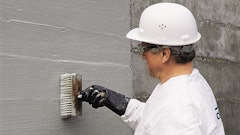
Thousands of municipalities are facing the fact that their concrete infrastructure is deteriorating. Waste, potable, and other water systems are approaching the later phases of their lifecycles. They typically show signs of cracking, positive or negative side leaks, spalling, reinforcement deterioration, freeze-thaw cycling, and all other manifestations of weathering and aging.
For towns with aging concrete water tanks, the dilemma is usually the same: repair or build new. In repair, re-waterproofing can buy another decade or two so they can budget for the new expense.
 The Vergenes-Panton concrete water tank.Gregory Maugeri / Bill Della Sorte
The Vergenes-Panton concrete water tank.Gregory Maugeri / Bill Della Sorte
The standards that govern tanks vary but usually want to limit any leaking to at or below 0.1% of the total volume of water for a 24-hour period. In large tanks, this can be negligible and typically within the evaporative levels. As the Vergennes tank is 750,000 gallons, 0.1% would be 750 gallons of allowable leakage, or 100 cubic ft.
In Vergennes’ case, the square tank was experiencing leaks from cracking, spalling from freeze-thaw cycling, and joints that had separated. New England Dry Concrete worked with the Vermont-based engineering firm DuBois & King, Inc. on what has become the state’s approved method for dealing with such problems. Based on the repairs done for similar sized and aged tanks, repairs were estimated to take approximately two to three weeks.
New England Dry Concrete LLC removed all deteriorated and weakened spalled concrete along with any loose and foreign material. The surface was chipped by mechanical means to expose a minimum of 1/16-in. of new aggregate concrete with a minimum depth of repair up to 1/2-in. with neat saw-cut dovetails at the perimeter.
 The Vergenes-Panton concrete water tank.Gregory Maugeri / Bill Della Sorte
The Vergenes-Panton concrete water tank.Gregory Maugeri / Bill Della Sorte
The interior was pressure washed prior to applying the surface waterproofing slurry. The pressure washing contained sporocidin (a phenol-based bactericidal, virucidal, moldicidal, fungicidal and tuberculocidal) as a broad-spectrum disinfecting agent. This allowed workers to continue to work in the tank environment safely.
The Kryton Krystol line of crystalline repair materials were used exclusively– requiring a cure of 72 hours depending on conditions. The tank could then be refilled with water after 48 (curing will continue). At that time, leakage testing was conducted using the AWWA standard for concrete tanks and disinfected using AWWA 652 Method 3.
 Allnex water tankGregory Maugeri / Bill Della Sorte
Allnex water tankGregory Maugeri / Bill Della Sorte
Billy Della Sorte, a partner of New England Dry Concrete, explains “Tanks that are 40+ years old begin to show significant signs of deterioration, in freezing climates or wastewater tanks it can show much sooner.” However, repairs are easier and far less expensive if you get out in front of them. Once you reach a certain tipping point, the repairs are extensive and much more costly. Where early repairs could be X, two years later they can be five times that. It is not a linear progression.
The Allnex tank was experiencing the same type of deterioration as observed among tanks of its age. The circular tank was older and wire-wound. This is a process that wraps a continuous cable around the outer walls of the concrete tank, and then the wrapping is typically covered in a cementitious material, perhaps shotcreted or stuccoed over. Eventually, either weathering or internal leaks begin to corrode the wire and spalling occurs. This process accelerates over time.
Repair
 Gregory Maugeri / Bill Della Sorte
Gregory Maugeri / Bill Della Sorte
The balance of the repairs is done in crystalline products. The use of surface-applied materials, admixes, or other specifically formulated products to deal with cracks, leaks, and spalling are employed. Done correctly, these repairs are solid and should endure.
While the Vergenned tank was about 25-ft. high with 5-ft. below grade, the same methods of applying crystalline waterproofing to the negative (the inside of the tank) can be employed when below grade.
The concrete water tank is a class of infrastructure that can be vulnerable if ignored. Replacement costs are tremendous and getting in front of repairs is essential. Contractors do have an arsenal of specialized products engineered to address the conditions that plaque this class of infrastructure. In addition to these, there are reliable methods for stabilizing water-challenged assets. Tanks, tunnels, dams, even deep foundations all can benefit from this approach. As remarkable as crystalline products and systems are, firms specializing in these kinds of repairs, designers and asset owners would be well-served to temper expectations. Products and methods are solid, but there are limitations.
Remember to get in front of it, it’s manageable. If you are after the tipping point or miss the window completely, it can be very expensive or irreparable; “an ounce of prevention is worth a pound of cure” is especially true in concrete.
About the author
Greg Maugeri is the co-founder and managing partner of New England Dry Concrete LLC.



























